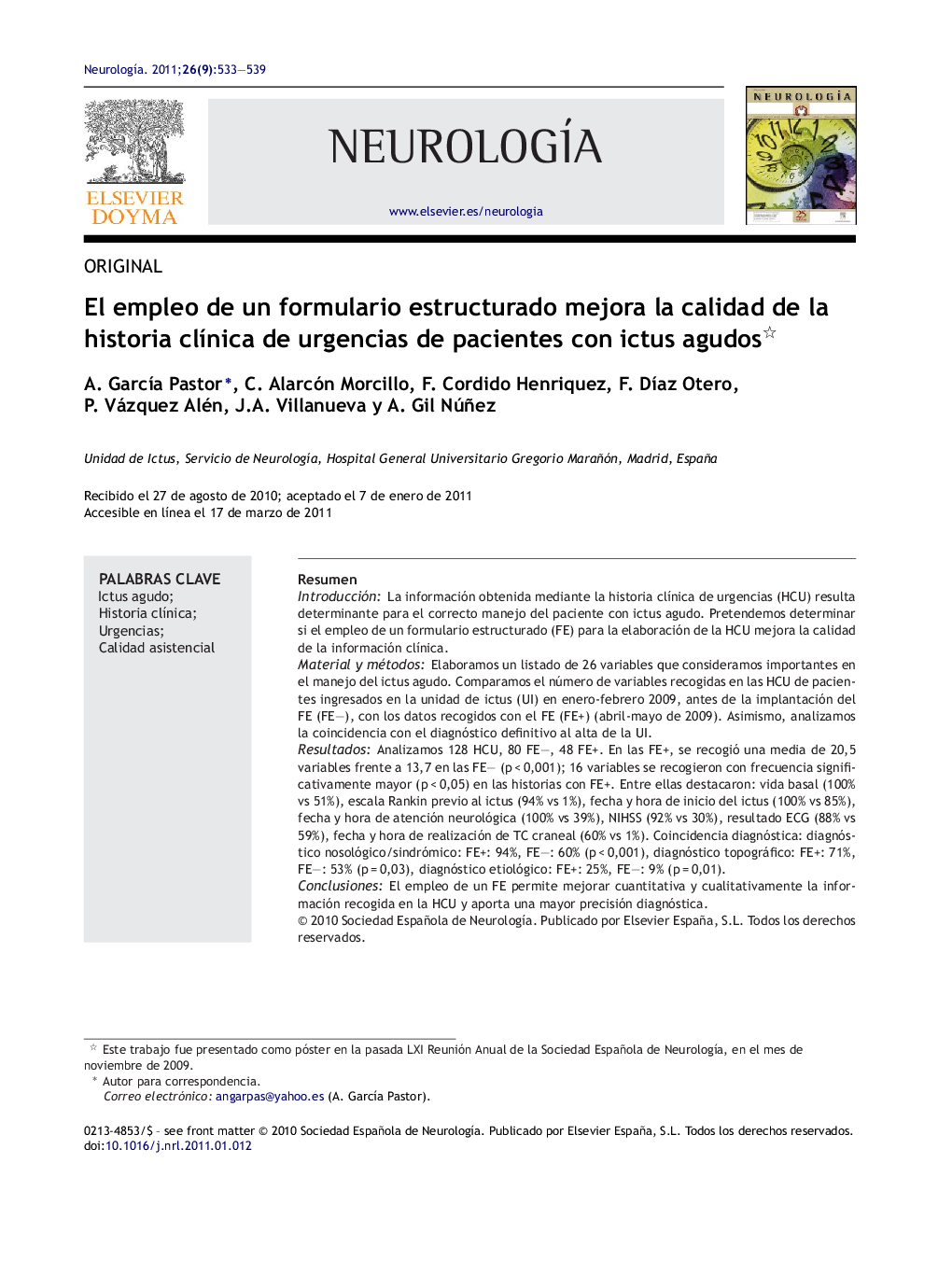| Article ID | Journal | Published Year | Pages | File Type |
|---|---|---|---|---|
| 3076420 | Neurología | 2011 | 7 Pages |
ResumenIntroducciónLa información obtenida mediante la historia clínica de urgencias (HCU) resulta determinante para el correcto manejo del paciente con ictus agudo. Pretendemos determinar si el empleo de un formulario estructurado (FE) para la elaboración de la HCU mejora la calidad de la información clínica.Material y métodosElaboramos un listado de 26 variables que consideramos importantes en el manejo del ictus agudo. Comparamos el número de variables recogidas en las HCU de pacientes ingresados en la unidad de ictus (UI) en enero-febrero 2009, antes de la implantación del FE (FE–), con los datos recogidos con el FE (FE+) (abril-mayo de 2009). Asimismo, analizamos la coincidencia con el diagnóstico definitivo al alta de la UI.ResultadosAnalizamos 128 HCU, 80 FE–, 48 FE+. En las FE+, se recogió una media de 20,5 variables frente a 13,7 en las FE– (p < 0,001); 16 variables se recogieron con frecuencia significativamente mayor (p < 0,05) en las historias con FE+. Entre ellas destacaron: vida basal (100% vs 51%), escala Rankin previo al ictus (94% vs 1%), fecha y hora de inicio del ictus (100% vs 85%), fecha y hora de atención neurológica (100% vs 39%), NIHSS (92% vs 30%), resultado ECG (88% vs 59%), fecha y hora de realización de TC craneal (60% vs 1%). Coincidencia diagnóstica: diagnóstico nosológico/sindrómico: FE+: 94%, FE–: 60% (p < 0,001), diagnóstico topográfico: FE+: 71%, FE–: 53% (p = 0,03), diagnóstico etiológico: FE+: 25%, FE–: 9% (p = 0,01).ConclusionesEl empleo de un FE permite mejorar cuantitativa y cualitativamente la información recogida en la HCU y aporta una mayor precisión diagnóstica.
IntroductionThe information obtained from the Emergency Medical Chart (EMC) is a key factor for the correct management of acute stroke. Our aim is to determine if the use of a pro-forma (PF) for filling in the EMC improves the quality of the clinical information.Material and methodsA PF was created from a list of 26 key-items considered important to be recorded in an EMC. We compared the number of items recorded in the EMC of patients admitted to our Stroke Unit (SU) in January-February 2009 (before PF was introduced) with the data obtained with the PF (April-May, 2009). We also analysed the agreement with the final diagnosis on discharge from the SU.ResultsA total of 128 EMC were analysed, and the PF was used in 48 cases. The mean number of recorded items was 20.5 for the PF group and 13.7 for the non-PF charts (P < .001). Sixteen of the 26 items were recorded significant more frequently (P < .05) in the PF Group. The most notable scores being: previous baseline situation (100% vs 51%), previous Modified Rankin scale score (94% vs 1%), time of symptom onset (100% vs 85%), time of neurological evaluation (100% vs 39%), NIHSS score (92% vs 30%), ECG results (88% vs 59%), time of perform brain scan (60% vs 1%). Diagnostic agreement: nosological/syndromic diagnosis: PF group: 94%, Non-PF group: 60% (P < .001), topographic diagnosis: PF: 71%, Non-PF: 53% (P = .03), aetiological diagnosis: PF: 25%, Non-PF: 9% (P = .01).ConclusionsThe use of a PF improves the quantity and quality of the information, and offers a better diagnostic accuracy.
